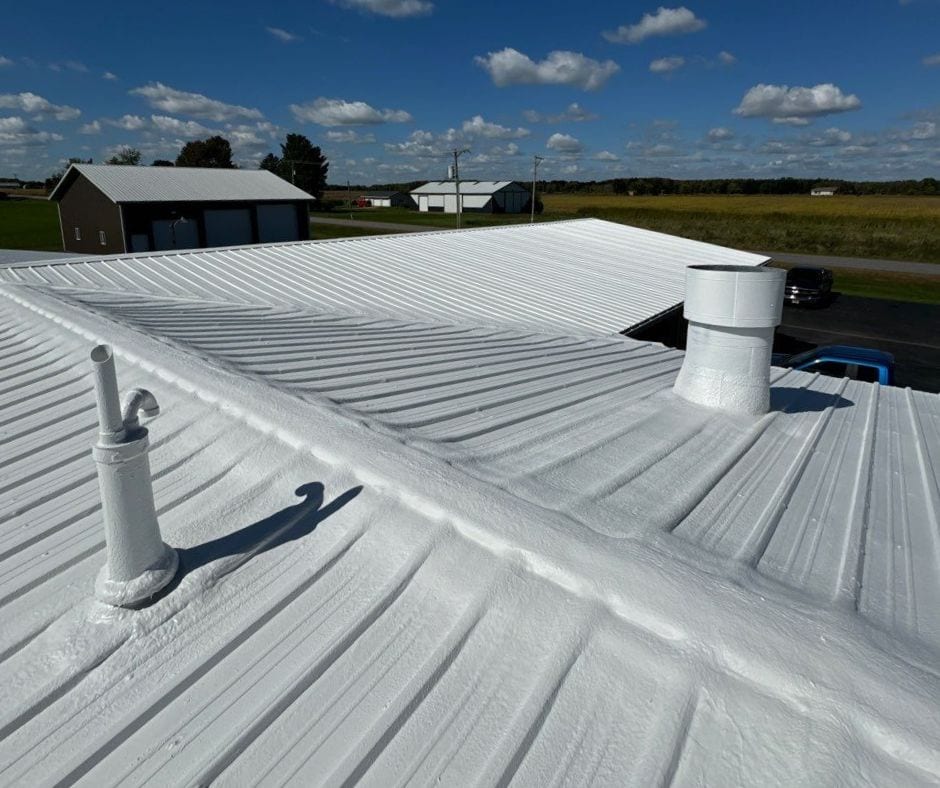
Completed spray foam job covering a ridge cap, around protrusions, and the various angles of the roof.
Spray foam roofing systems came into popularity in the 1980s. Since then, they have grown as a popular option for business owners seeking to restore and reuse their old commercial roof. Spray foam waterproofs the roof, insulates the building, and strengthens the roof structure.
However, like any advanced technology, spray foam roofing requires careful, professional installation to deliver long-lasting results.
At SR Commercial Roofing, we’ve worked through multiple challenges that arise during installation, so we know how to properly tackle a spray foam roof restoration to ensure your roof’s performance and longevity.
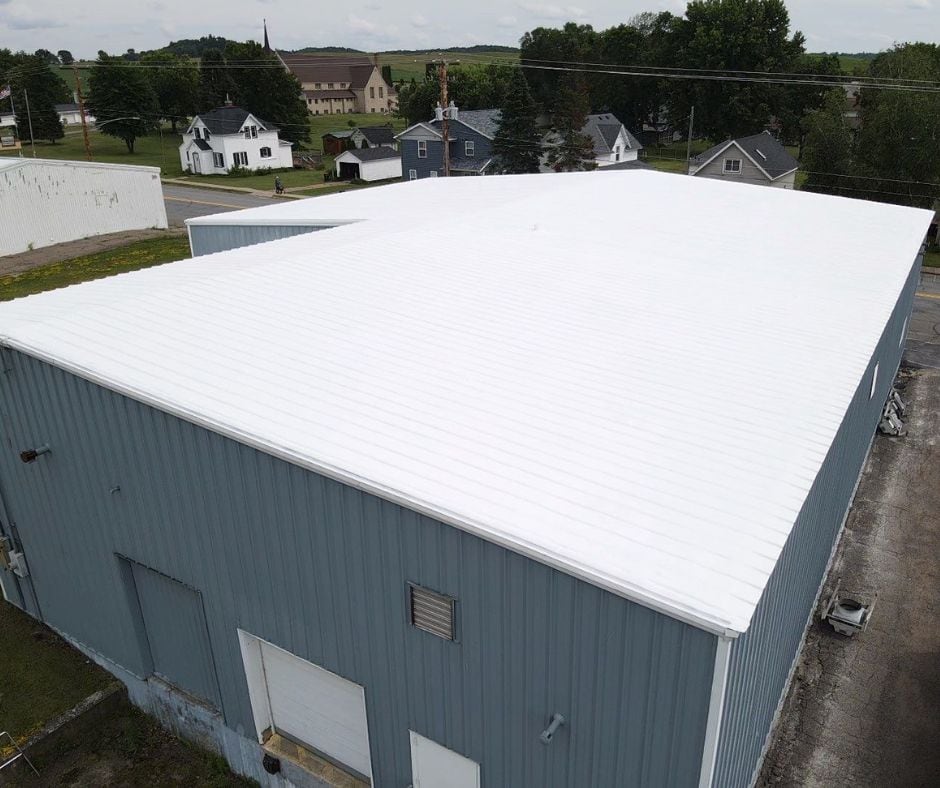
Completed spray foam job covering a simple sloped roof.
What is Spray Foam?
Spray foam is a polyurethane-based product that is sprayed as a liquid onto a roof or inside a building. After being sprayed, it expands and hardens to insulate the building and strengthen the structure. Spray foam has two primary applications: interior and exterior.
Interior Spray Foam
When spray foam is used inside, it is typically for insulation and soundproofing. The foam used on the interior of buildings is less dense than exterior foam because it expands more after being sprayed. Interior foam’s expansion makes it excellent for filling all the interior nooks and crannies of a building [1]. But because of its lower density, it is not waterproof nor is it as strong as the foam used on the exterior of buildings.
Exterior Spray Foam
When spray foam is used on a roof, the foam sets in a tight, dense structure making it both waterproof and stronger than interior foam. Exterior foam is used to insulate the roof, to prevent water from seeping into the building, to strengthen the roof’s structure, and to withstand the foot traffic of maintenance crews checking the roof, HVAC units, pipes, etc.
Now that we know what spray foam is and the basics of how it works, what are the problems you can experience when applying spray foam?
1. Ponding Water (Roof Slope)
Many roofs are improperly sloped, which creates ponds of water on the roof as snow melts or after storms. Ponds on the roof lead to mold, mildew, and rust which hasten the deterioration of the roof’s materials. If spray foam is applied without consideration for the current slope of the roof, then the problem with ponding water will continue.
To fix a ponding water issue, we observe where water collects on the roof. Next, we plan to spray foam thicker near any corners, edges, or other areas where water is ponding. By spraying the foam thicker in trouble areas, we strategically re-slope the roof and ensure that water drains off the roof. If it is a flat roof, we may slope the whole roof towards one edge so that water is running off the roof.
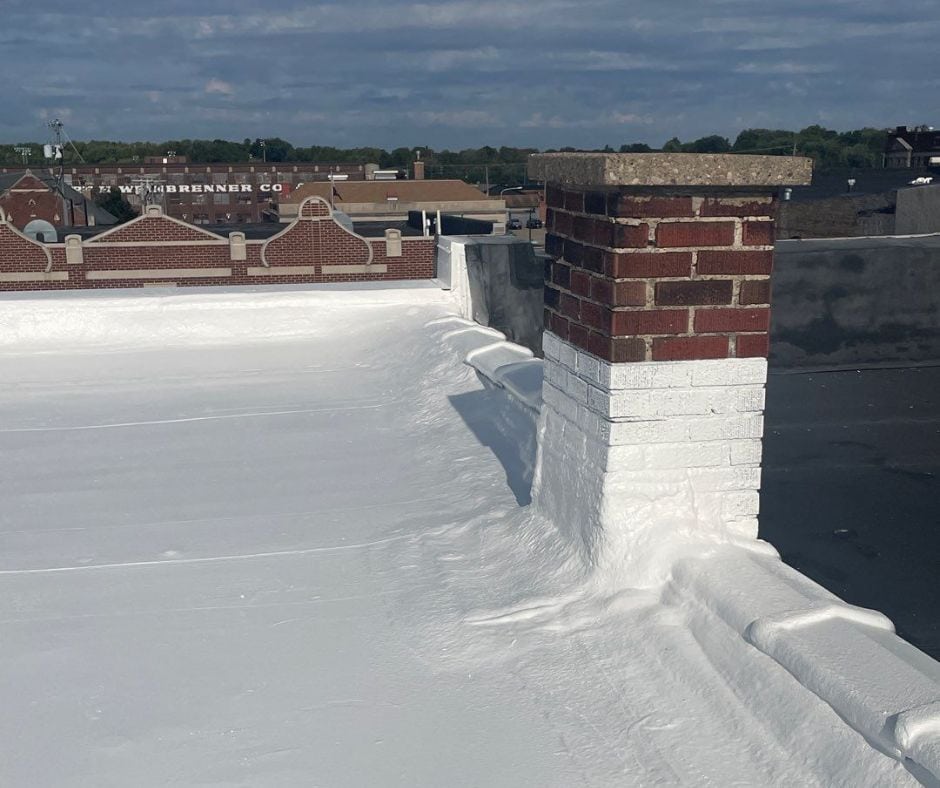
Foam sprayed along edges and corners to improve drainage.
After getting a plan in place, we wait for fair weather.
2. Weather Constraints
Spray foam requires specific conditions to cure properly: a clean surface, a clear day, and warm temperatures. A dirty roof, rain, and cold temperatures can negatively impact foam as it is sprayed and cause uneven expansion, curing issues, or poor adhesion—leading to cracks or blistering.
To avoid these issues, we thoroughly clean and dry the roof before spraying foam to ensure it will adhere to the roof properly.
We do not spray foam during rainfall because any moisture in the foam causes blistering as the water droplets get trapped in the foam. However, minutes after the spray foam is applied it will cure out and become waterproof, so rainfall shortly after spraying foam is no issue.
Finally, we do not typically spray foam at temperatures below 60 degrees because the cold causes foam to expand unevenly and take longer to cure.
Once the weather permits, we are ready to gear up for a day of spraying foam.
3. Safety
Spray foam contains chemicals that require careful handling to protect our crew. Mishandling can result in health issues if spray foam is inhaled or sticks to someone’s skin (especially if exposed to spray foam for years as a roofer).
Safety is a high priority. All SR Commercial Roofing team members wear high-quality masks to protect their lungs when the foam is being sprayed. We also encourage everyone on the roof to wear long sleeves and long pants to protect their skin from the foam.
We’re all geared up, so let’s apply the foam!
4. Overspray
Since spray foam is a liquid that expands and solidifies, it is challenging to ensure that the foam will be fully, smoothly applied to the roof and to avoid overspray. Overspray, where foam lands on unintended surfaces, can cause aesthetic problems and material waste.
When applying spray foam, the roofing crew’s goal is to avoid over-spraying onto cars parked near the side of a building or onto the walls of the roof or onto protrusions like HVAC units. On the flip side, however, they also want to avoid inconsistent coverage on the roof which can lead to thin spots, reducing the roof’s waterproofing effectiveness or creating ponding on the roof.
To avoid these two issues, we use precise, calibrated spray equipment (composed of a foam rig, hoses, and a spray foam gun) operated by a spray foam expert with years of experience. We have another man carry the heavy, bulky hoses to the spray foam gun so that the expert applying the foam does not have to drag the hoses while spraying which could result in an inconsistent application.
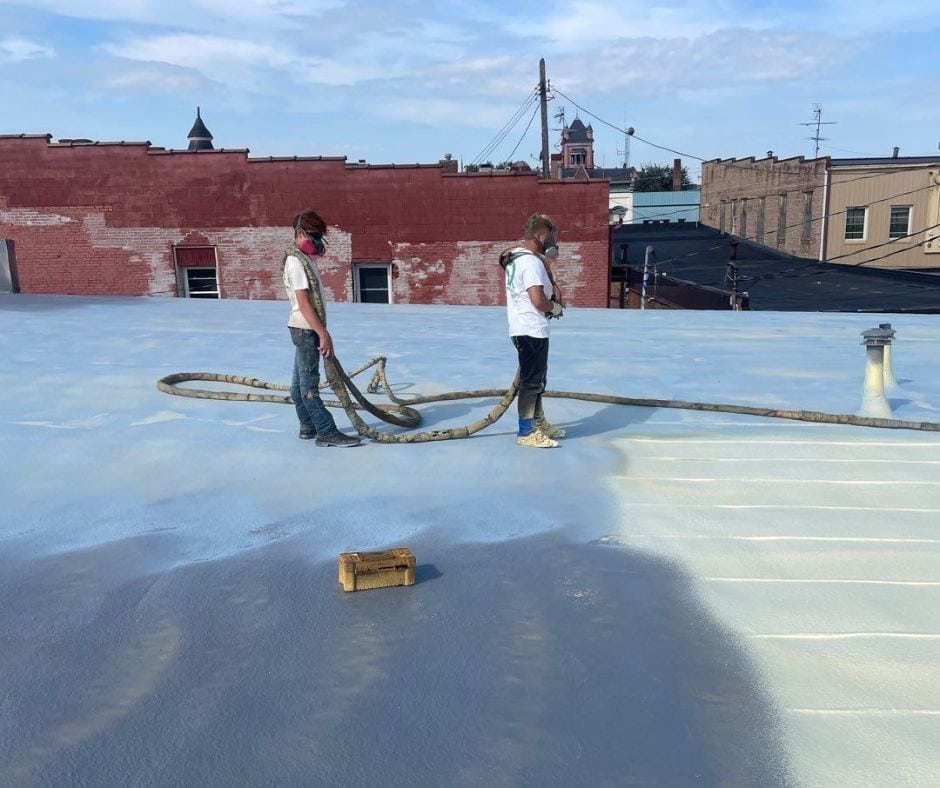
Guy on the right is spraying foam;. Guy on the left is carrying the hoses for the spray foam gun.
Lastly, we have one or two other guys holding boards to protect exterior walls or roof protrusions from overspray.
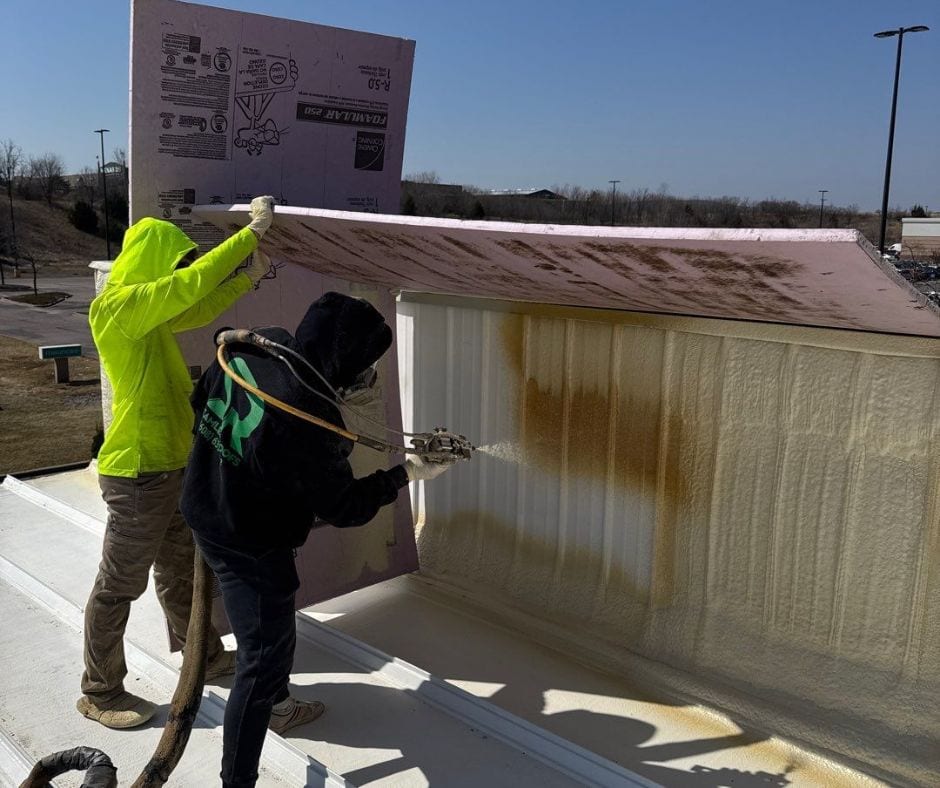
Holding boards to prevent overspray.
Once the spray foam is cured, we conduct thorough surface inspections to guarantee full coverage and to cut off any overspray that did occur, if any.
Next, we need to protect the foam from sunlight.
5. UV Rays
UV rays from the sun can quickly deteriorate spray foam and cause it to crack.
So, after spraying foam, we spritz it with primer or base coat to temporarily protect it from the sun. Then we return within 1-2 days to fully coat the roof with our base coat and top coat which will fully guard against UV deterioration and add additional waterproofing protection.
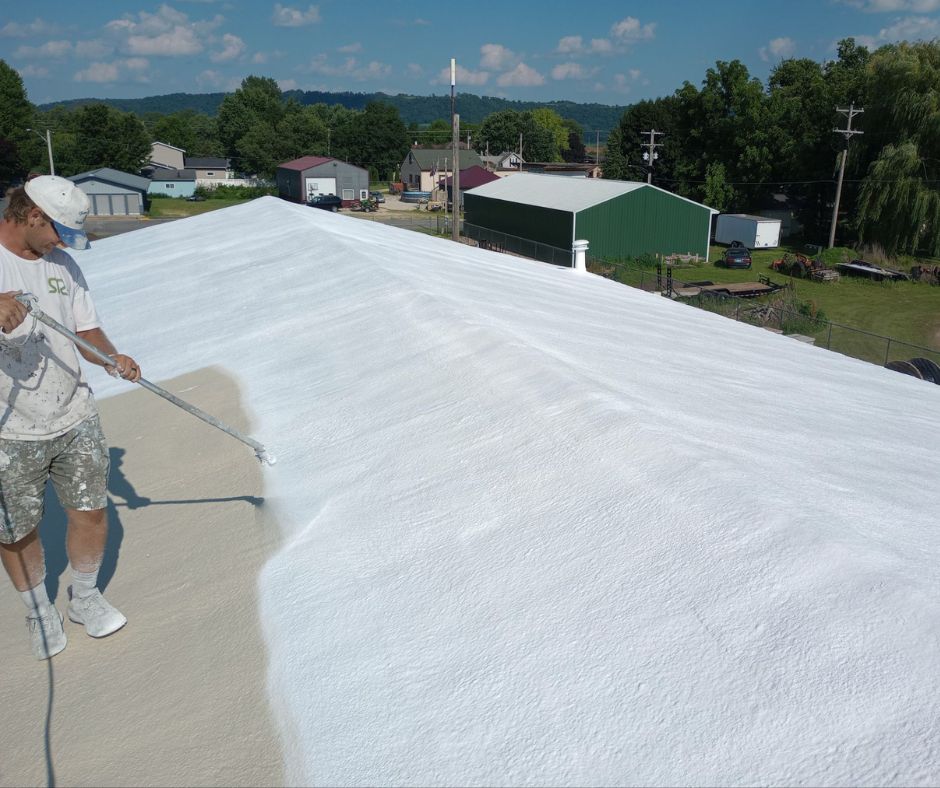
Spraying coatings over the foam.
Final Thoughts
Spray foam roofing offers wonderful advantages. It is light (not heavy extra burden on the roof), strong (adheres seamlessly to the entire roof to shore up weak points and tie them into the entire roof), waterproof, and insulator. But these advantages only kick in when the foam is installed with professional tools, skill, and care.
At SR, we have over 10 years of experience in restoring roofs, working with the same quality products, and ensuring our customer receives the restored roof and customer service they expect and deserve.
If you are interested in a professional spray foam roof restoration, call Warren at 608-844-4933. He is always happy to answer any questions you have about spray foam! Additionally, we can setup a free inspection and quote and discuss what roof options fit your situation to ensure your restored roof will perform flawlessly for decades.
Citations
[1] https://patriotdistribution.com/pages/team
